Leaking amniotic fluid is a critical concern for pregnant women, as it can signal potential complications requiring immediate attention. The topic of this guide will cover all you need to know about amniotic fluid leak, its symptoms, causes, and ways to control it in order to gain power during pregnancy.
Table of Contents
- What Is Amniotic Fluid and What Is Its Role in Pregnancy?
- What Causes an Amniotic Fluid Leak?
- Leaking Amniotic Fluid Signs to Watch For
- How to Tell If You’re Experiencing an Amniotic Fluid Leak
- Symptoms of Leaking Amniotic Fluid in Detail
- Can Amniotic Fluid Leak and Then Stop?
- How to Know If You Are Leaking Amniotic Fluid
- Testing for Amniotic Fluid Leak at Home
- When to Seek Medical Help for Leaking Amniotic Fluid
- Potential Risks of an Amniotic Fluid Leak
- Diagnosis and Medical Tests for Leaking Amniotic Fluid
- Treatment Options for Leaking Amniotic Fluid
- Emotional Impact of Leaking Amniotic Fluid
- FAQ About Leaking Amniotic Fluid
- Long-Term Outlook for Amniotic Fluid Leak
- Conclusion: Stay Vigilant About Leaking Amniotic Fluid
What Is Amniotic Fluid and What Is Its Role in Pregnancy?
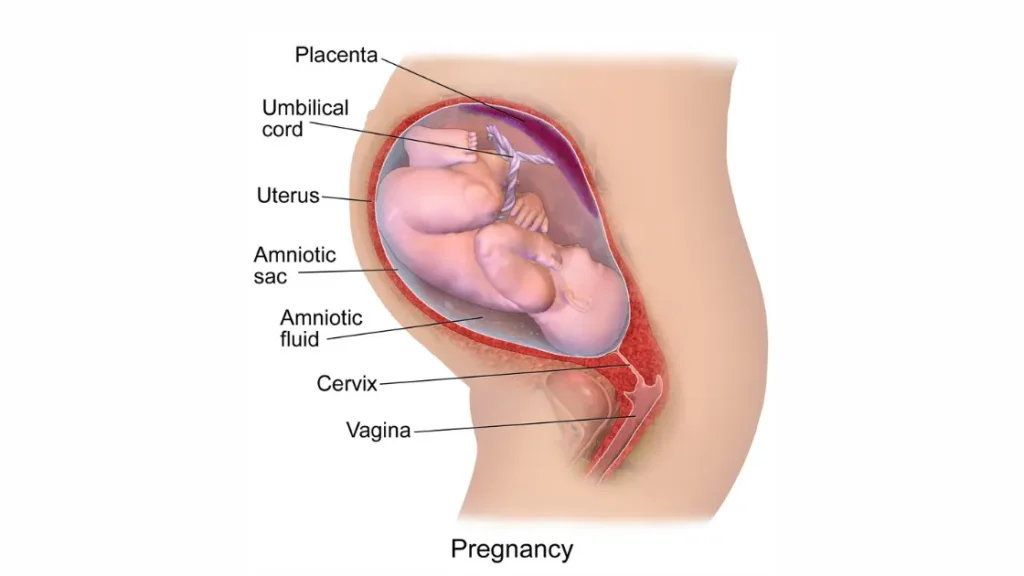
The amniotic sac surrounds your baby in the womb with amniotic fluid, which protects it. It absorbs the growing fetus, maintains temperature and sustains the increasing body. Interrupted sac or tear in the sac might provide amniotic fluid leakage and it can cause risks such as preterm delivery or infection unless it is taken care of on time.
This fluid is typically clear or slightly yellowish and odorless. It’s distinct from urine or vaginal discharge, though distinguishing them can be challenging. Understanding its role helps you recognize why any leaking amniotic fluid warrants attention.
What Causes an Amniotic Fluid Leak?
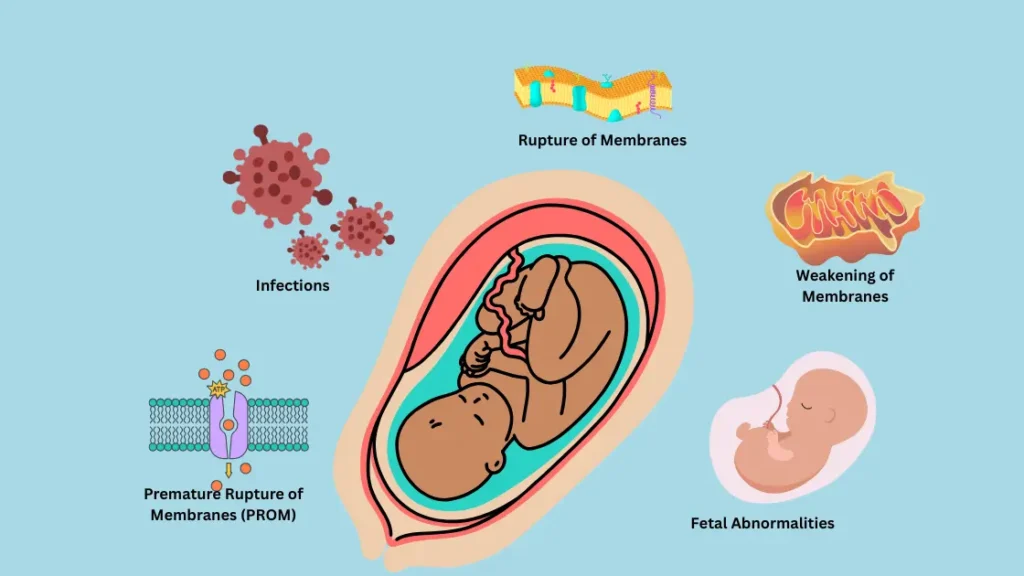
A rupture of the amniotic fluid may occur due to a number of reasons. Preterm rupture of membranes (PROM) prior to 37 weeks or complete term rupture prior to the onset of labor is not unusual. Additional causes are infections, abdominal injury, pressure on the amniotic sac as a result of twins, or too much fluid. There is a possibility that the probability can increase as a result of potential risk factors like smoking, poor diet, or prior preterm labor. You can seek care right away and stay vigilant for any signs of amniotic fluid leakage if you understand these reasons.
Leaking Amniotic Fluid Signs to Watch For
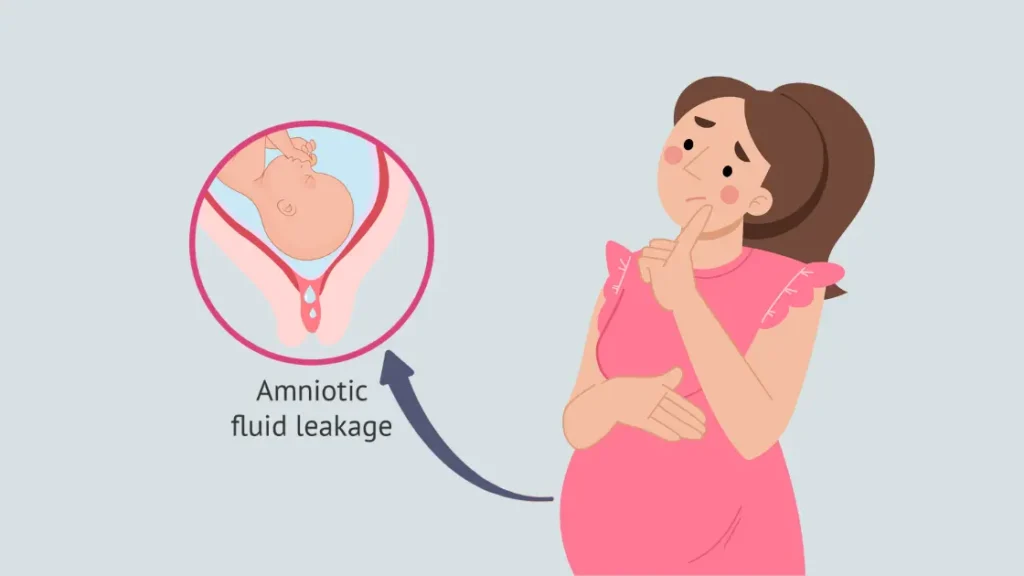
It is very important to be able to identify the signs of a leaked amniotic fluid in order to act quickly. Common signs and symptoms include:
- Abrupt or slow flow of fluid out of the vagina.
- Clear or slightly pink or pale yellow, with little odor.
- A sensation of wetness that persists despite changing pads.
Unlike urine, which you can control, amniotic fluid leak flows involuntarily. If you notice these signs, contact your healthcare provider immediately to assess the situation.
How to Tell If You’re Experiencing an Amniotic Fluid Leak

Leaking amniotic fluid should be seen pointing out as well This is commonly confused with pee or discharge. Here is how to distinguish:
- The amniotic fluid is generally odorless in contrast to the smell of urine.
- It may continue to leak steadily or intermittently, unlike discharge, which is typically thicker.
- Lying down and standing up may increase the flow of leaking amniotic fluid.
If you are unsure, avoid using tampons or douching, which can introduce bacteria. Instead, see your doctor for testing to confirm a leak in amniotic fluid.
Symptoms of Leaking Amniotic Fluid in Detail

The symptoms of leaking amniotic fluid vary in intensity. You might experience:
- A feeling of wetness in your underwear that doesn’t stop.
- Fluid that soaks through pads or clothing.
- Occasional small leaks that seem to stop and start.
These symptoms of leaking amniotic fluid may be subtle, making them hard to detect. Monitoring how your body is changing and discussing it with your doctor means that you will not miss possible problems.
Can Amniotic Fluid Leak and Then Stop?
A common question is, can amniotic fluid leak and then stop? Yes, there are instances where a tiny hole in the amniotic sac can close up, temporarily sealing the leakage. This would be more probable in the case of small-sized leaks created by pressure or a small tear. Nevertheless, when it is stopped, the leakage does not eliminate the risks of being exposed to infections or the risk of lowering fluid levels, which will impact the development of your baby. Nevertheless, you should inform your medical care provider of every instance of possible amniotic fluid leak, and they can advise you on how to protect yourself and your unborn child through monitoring or other interventions.
How to Know If You Are Leaking Amniotic Fluid
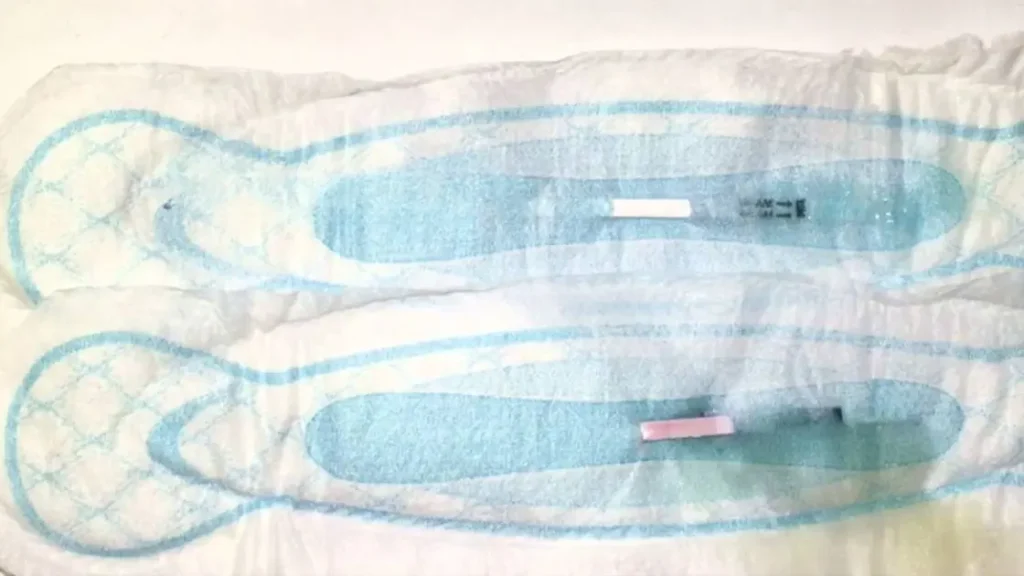
To determine if you are leaking amniotic fluid, pay attention to the fluid’s characteristics and frequency. Unlike discharge, which may be sticky or mucous-like, amniotic fluid is typically watery. You might notice:
- A consistent trickle that doesn’t stop with pelvic floor exercises.
- Fluid that pools when you lie down and flows when you stand.
If you suspect a leak, your doctor can perform tests like a nitrazine test or ultrasound to confirm leaking amniotic fluid.
Testing for Amniotic Fluid Leak at Home
While professional diagnosis is best, some women try an amniotic fluid leak test at home. One method involves:
- Emptying your bladder and putting on a clean pad.
- Observing wetness within one hour whilst resting or moving.
- Verifying the color, smell, and consistency of the fluid.
Home tests aren’t infallible, though. To prevent care delays, if you believe your baby is leaking amniotic fluid, speak with your healthcare provider about precise testing, like an AmniSure test.
When to Seek Medical Help for Leaking Amniotic Fluid

Don’t wait if you notice any indications of leaking amniotic fluid. Get in touch with your physician or midwife right away, particularly if you observe:
- A sudden gush of fluid.
- Persistent wetness without an obvious cause.
- Accompanying symptoms include contractions, fever, or reduced fetal movement.
Early detection of leaking amniotic fluid symptoms ensures prompt interventions, lowering risks such as infection or premature delivery.
Potential Risks of an Amniotic Fluid Leak
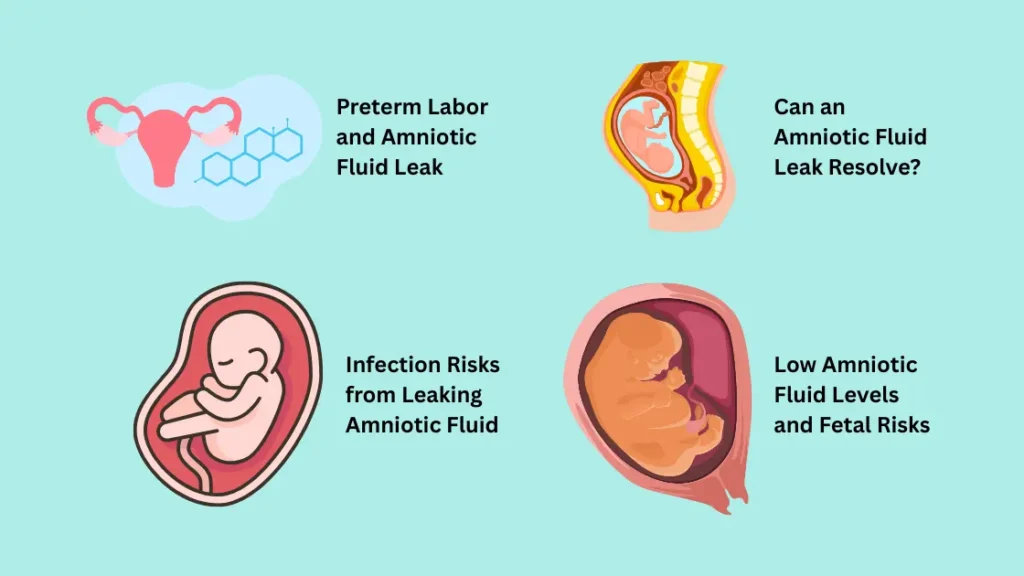
An amniotic fluid leak can result in serious issues if not treated immediately. Mothers-to-be should be warned that these treatments have risks: infection, early delivery and decreased amniotic fluid. The symptoms of leaking amniotic fluid can be identified easily by taking caution, as this will help in reducing the risks associated with it.
Infection Risks from Leaking Amniotic Fluid
In the cases when an amniotic sac is torn apart, it provides the bacteria the opportunity to enter the body, which can in turn cause chorioamnionitis, a serious condition of infection of the amniotic membranes. Symptoms of leaking amniotic fluid accompanied by fever, uterine tenderness, or foul-smelling discharge may indicate this condition. Chorioamnionitis may damage the mother and child, putting them at risk of sepsis or postpartum infection. Whether you suspect leakage of amniotic fluid, prompt care is needed because antibiotics or delivery would be necessary to avoid complications. Regular prenatal care can help detect infections early, reducing risks associated with leaking amniotic fluid.
Preterm Labor and Amniotic Fluid Leak
An amniotic fluid leak before 37 weeks can trigger preterm labor, a major concern for fetal health. The loss of fluid may stimulate contractions, leading to early delivery. Knowing if you are leaking amniotic fluid is critical here, as early leaking amniotic fluid signs like a sudden gush or trickle warrant immediate medical evaluation. The preterm infants can experience such problems as respiratory distress or developmental delays. Depending on the extent of the leakage of amniotic fluid, doctors can employ drugs that can delay childbirth or some medications that will aid in the development of the fetus’s breathing system, e.g., steroids.
Low Amniotic Fluid Levels and Fetal Risks
Low amniotic fluid levels, known as oligohydramnios, can result from an amniotic fluid leak, restricting fetal growth and movement. This condition may cause umbilical cord compression, reducing oxygen and nutrient supply to the baby. How to tell if leaking amniotic fluid is occurring involves monitoring for persistent wetness or reduced fetal movement. Ultrasounds can confirm low fluid levels, guiding treatment like increased hydration or, in severe cases, early delivery. Addressing signs of leaking amniotic fluid early helps protect your baby’s development.
Can an Amniotic Fluid Leak Resolve?
In some cases, small leaks may stop if the tear seals itself, addressing the question, can amniotic fluid leak and then stop? But whenever this leak ceases, there are chances of danger, such as infection or low fluid levels. An amniotic fluid leak test at home can provide clues, but professional tests like nitrazine or AmniSure are vital for accurate diagnosis and management.
Diagnosis and Medical Tests for Leaking Amniotic Fluid
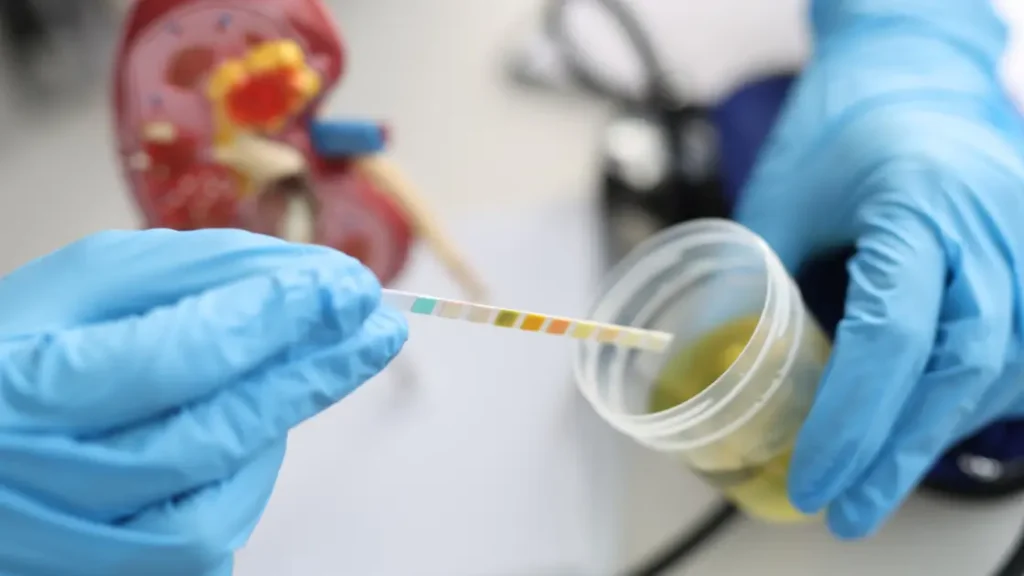
It is important to provide confirmation that there was a leakage of the amniotic fluid so as to make an intervention. Healthcare providers use specialized tests to distinguish leaking amniotic fluid from urine or discharge. Being aware of the symptoms and correct diagnosis methods using tests such as nitrazine test, fern test or ultrasound can save your pregnancy.
Nitrazine Test for Amniotic Fluid Leak
The nitrazine test is a simple, non-invasive method to detect leaking amniotic fluid. It tests the pH of vaginal fluid since the amniotic fluid is more alkaline (pH 7.0-7.5) than other body secretions, such as urine, and vaginal discharge (pH 4.5-6.0). A swab is used to take a fluid sample, which is applied to nitrazine paper by a healthcare provider. When the paper changes blue, it changes to imply the leakage of amniotic fluid. The procedure is rapid, but it can produce false positive results if there is blood or infection present — so it will frequently be combined with other tests to determine whether the amniotic fluid has indeed been leaking.
Fern Test to Identify Leaking Amniotic Fluid
The fern test examines vaginal fluid under a microscope to detect a fern-like pattern, a hallmark of leaking amniotic fluid. A sample is taken, dropped on a slide, and left to dry. When magnified, amniotic fluid undergoes crystallization in the form of a fern-like structure because of the presence of salts and proteins. This test is highly specific for symptoms of leaking amniotic fluid but requires skilled interpretation. It’s often used alongside other tests to confirm whether you are leaking amniotic fluid, especially when results are unclear.
Ultrasound to Assess Amniotic Fluid Leak
To determine whether there has been an amniotic fluid leak, an ultrasound measures the amount of amniotic fluid. It helps detect low levels (oligohydramnios) brought on by a leak by using sound waves to visualize the fluid volume surrounding the fetus. The integrity of the amniotic sac and fetal health are also examined by this non-invasive procedure. An ultrasound offers crucial information if you observe symptoms of leaking amniotic fluid, such as persistent wetness. To be more certain in the diagnosis, it is often employed together with fern or nitrazine test.
Role of Amniotic Fluid Leak Test at Home
Some women try an amniotic fluid leak test at home by keeping an eye on the color, consistency, and smell of fluid on a pad, even though professional testing is the most accurate. This approach isn’t conclusive, though. Home observations can help you to quickly seek medical confirmation if you are unsure, if you notice amniotic fluid leak and then stop, or if you notice intermittent leaks. To confirm leaking amniotic fluid signs with clinical tests, always seek medical advice.
Treatment Options for Leaking Amniotic Fluid

Treatment for an amniotic fluid leak depends on the pregnancy stage and severity. Options include:
- Monitoring: For small leaks in the short term, doctors may wait with close observation.
- Hospitalization: These premature leaks usually need bed rest and a course of antibiotics to stave off an infection.
- Delivery: If risks are high, inducing labor or a C-section may be necessary.
The treatment will be selected by your doctor according to your symptoms of leaking amniotic fluid and health.
Preventing Amniotic Fluid Leak
While not all leaks are preventable, you can reduce risks by:
- Maintaining good prenatal care to monitor for infections or complications.
- Avoiding smoking and managing chronic conditions like diabetes.
- Staying hydrated to support healthy amniotic fluid levels.
These steps can’t guarantee prevention, but may lower the chances of an amniotic fluid leak.
Emotional Impact of Leaking Amniotic Fluid

Leaking amniotic fluid can endanger the health of your unborn child. For most investors, it will not be easy; it is natural to fear the worst. To deal with:
- Discuss with your healthcare provider freely.
- Remember to lean on friends and family or pregnancy support groups.
- Engage in stress management such as deep breathing.
Addressing the emotional toll of an amniotic fluid leak is as important as physical care.
FAQ About Leaking Amniotic Fluid
What are the main signs of leaking amniotic fluid?
Look for a sudden gush or steady trickle of clear, odorless fluid that persists despite changing pads.
Can amniotic fluid leak and then stop?
Yes, small tears may seal temporarily, but you should still seek medical advice to rule out risks.
How to tell if leaking amniotic fluid vs. urine?
Amniotic fluid is odorless and flows uncontrollably, unlike urine, which has a distinct smell and can be controlled.
What is an amniotic fluid leak test at home?
Monitor fluid on a pad for an hour, noting its color and consistency, but always confirm with a doctor.
How do you know if you are leaking amniotic fluid?
Check for persistent wetness, watery fluid, and lack of odor. Consult a doctor for confirmation.
Long-Term Outlook for Amniotic Fluid Leak
Late gestation minor leaks often close spontaneously while those in early gestation may require some intensive care. The good news is that most women can have a healthy pregnancy if they treat their gestational diabetes quickly. Consistent prenatal care and open dialogue with your physician will be essential in controlling leaking amnio fluid.
Conclusion: Stay Vigilant About Leaking Amniotic Fluid
Recognizing the symptoms of leaking amniotic fluid and spotting it helps you to respond quickly. From taking an amniotic fluid leak test at home or contacting a physician, you need to catch this early. You can stay informed, listen to your gut, and discuss it with the healthcare provider so you and your baby can get the best outcome.
Stay updated with every concern that may rise in pregnancy with Pregnancy Must –
- Gestational Hypertension Vs Preeclampsia: Protect Your Pregnancy
- Raised Folate Levels: Pregnancy’s Double-Edged Sword
- Anemia ICD 10 During Pregnancy: What Moms Should Know
- Uterine Involution: Restoring Your Body After Birth
